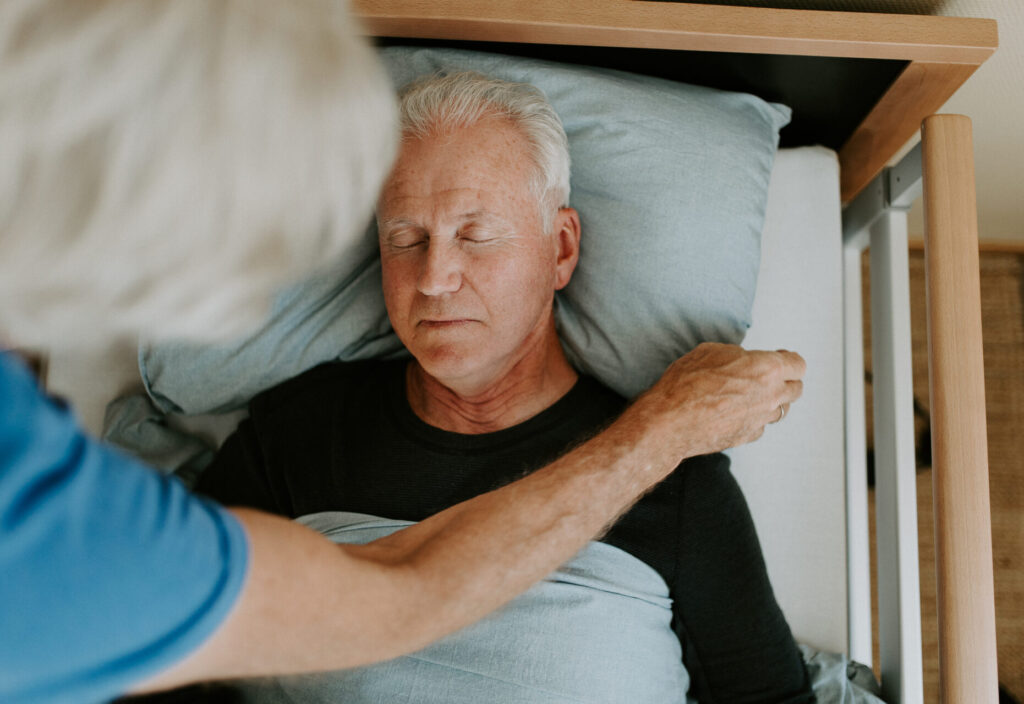Decubitus, or pressure ulcers, is a serious medical condition that affects people with reduced mobility or prolonged bed rest. These ulcers occur when the skin and underlying tissues are subjected to prolonged pressure, often over bony protrusions such as the coccyx, heels, hips, and elbows. The pressure restricts the blood supply to the area, which leads to tissue damage and, in the worst case, necrosis. In this article, we take a closer look at causes, risk factors and 7 effective measures to prevent and treat decubitus.
What is decubitus?
Decubitus (pressure ulcers) are wounds that develop when the skin is exposed to sustained pressure, shear forces or friction. It is particularly common among the elderly, people with spinal cord injuries, or those who have reduced mobility for other reasons. Decubitus is classified into four stages based on how deep the wound is:
Stage 1: Red skin that does not fade under pressure.
Stage 2: Superficial ulcer with damage to the epidermis or dermis.
Stage 3: Deeper wounds with damage to subcutaneous tissue.
Stage 4: Serious injury that reaches muscles, tendons or bones.
Who is at risk?
Several factors increase the risk of developing decubitus:
-
Prolonged bed rest or wheelchair use
-
Older people
-
Poor nutrition and fluid intake
-
Incontinence
-
Decreased sensitivity or nerve damage
-
Diseases such as diabetes, vascular disease or dementia
Prevention therefore requires a holistic focus on both physical, nutritional and medical condition.
1. Pressure relief and position changes
The most important strategy for preventing decubitus is regular pressure relief. Patients who are bedridden should change their lying position at least every two hours. When using a wheelchair, movement is recommended every 15 minutes.
There are special mattresses and seat cushions that distribute the pressure more evenly and reduce the strain on exposed body parts. For example, mattresses such as Tidewave and positioning pillows can have a significant effect.
2. Skin care and hygiene
Good skin care is essential. The skin should be kept clean, dry and free of urine and feces. Use mild soaps and avoid excessive friction when washing. Moisturizers are recommended to preserve the skin’s elasticity and prevent cracking.
In case of incontinence, it is important to clean quickly and use barrier creams to protect the skin from irritation.
3. Nutrition and fluid intake
Proper nutrition promotes wound healing and strengthens the skin. Protein, vitamin C, and zinc are especially important for tissue repair. Studies show that malnutrition significantly increases the risk of decubitus.
Ensure adequate fluid intake to maintain skin moisture and elasticity. A nutritionist can assist with assessment and adaptation of diet.
4. Risk assessment and documentation
Using risk assessment tools such as the Braden scale or the Norton scale helps healthcare providers identify patients at risk. These tools assess mobility, sensory function, moisture, nutritional status, and friction/shear.
Systematic documentation of skin status and implemented measures is crucial for good follow-up and early intervention.
5. Training of patients and relatives
Information and education are key to successful prevention. Patients and relatives should be trained in:
-
The importance of position changes
-
Use of assistive devices
-
Skin care and nutrition
-
Signs of incipient pressure ulcers
Increased knowledge contributes to better self-care and faster measures if symptoms occur.
6. Treatment of established pressure ulcers
Once decubitus is established, treatment depends on the stage of the wound. Key principles include:
-
Removal of dead tissue (debridement)
-
Infection control
-
Proper wound dressing
-
Pain relief
-
Optimal nutrition
In severe cases, surgical intervention may be necessary, especially at stages 3 and 4.
7. Interdisciplinary collaboration
Prevention and treatment of decubitus requires the efforts of several professional groups: nurses, doctors, nutritionists, physiotherapists and occupational therapists. Good cooperation ensures comprehensive follow-up and improves the patient’s prognosis.
Communication and common goal setting are crucial to ensure continuity and quality of treatment.
Summary
Decubitus is a serious and often painful condition that can have major consequences for the patient’s quality of life. Fortunately, in most cases, it can be prevented with simple but systematic measures. Regular posture changes, good skin care, proper nutrition, training and a strong interdisciplinary collaboration are key to reducing the incidence and improving treatment outcomes.
By being aware of the risk factors and implementing measures early, we can contribute to a better everyday life for vulnerable patient groups and avoid serious complications. Decubitus is a problem that can be significantly reduced with knowledge and the right efforts.

Why Tidewave is the superior solution against decubitus
Even with good effort and knowledge, it can be challenging to maintain consistent pressure relief – especially for patients with severely reduced mobility. This is where Tidewave makes a groundbreaking difference.
Tidewave is a revolutionary, patented solution that automatically and continuously moves the patient side to side, completely without the need for manual repositioning. This unique technology mimics the body’s natural movement patterns and provides gentle, even pressure relief – around the clock. Result? Fewer pressure ulcers, better sleep quality and less strain on healthcare personnel and relatives.
The advantages of Tidewave:
-
Automatic and silent movement – no manual repositioning required
-
Proven reduction in pressure ulcers and improved patient comfort
-
Reduced risk of occupational injuries and time spent in care
-
Adaptable technology for different patient groups and needs
Tidewave is not just an aid – it is an investment in dignity, security and sustainable care. With Tidewave, both patient and caregiver get an easier everyday life, and the healthcare system gets an effective solution that really makes a difference.
